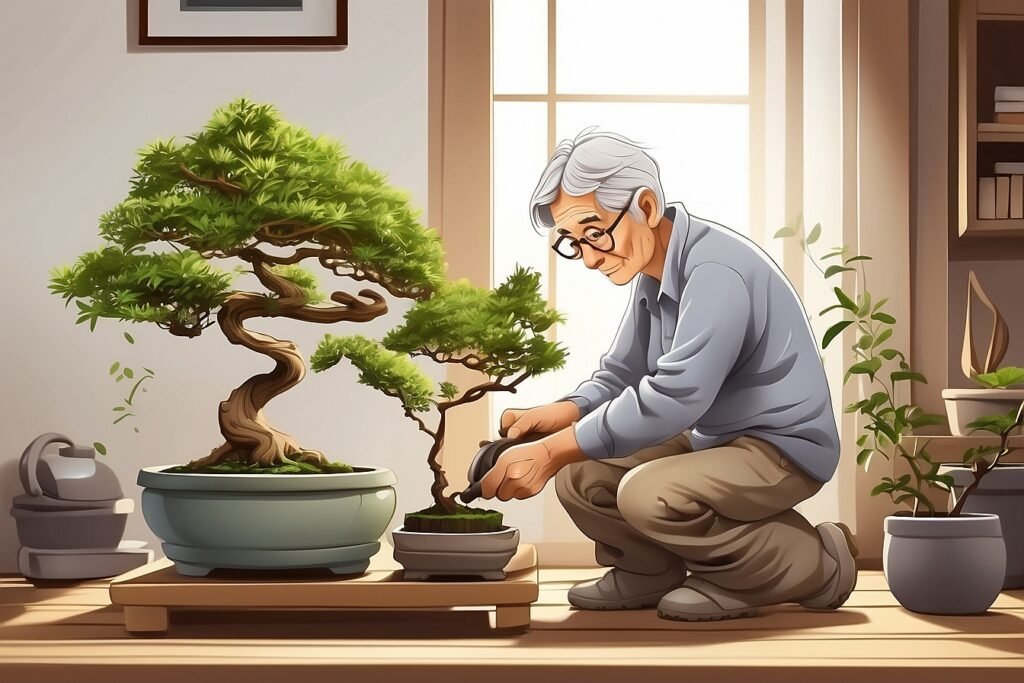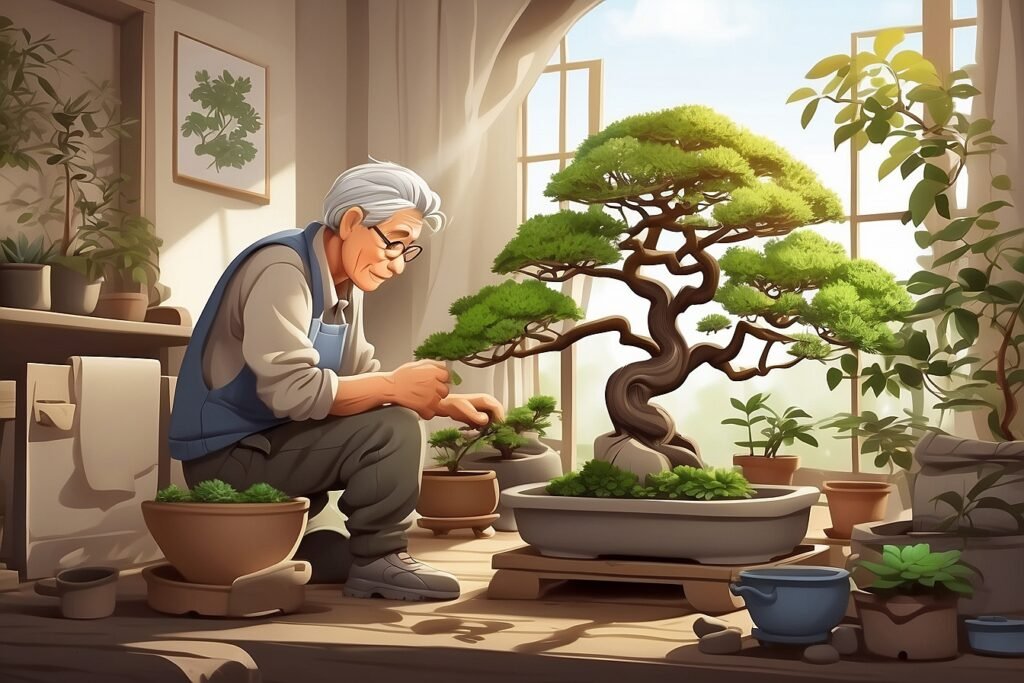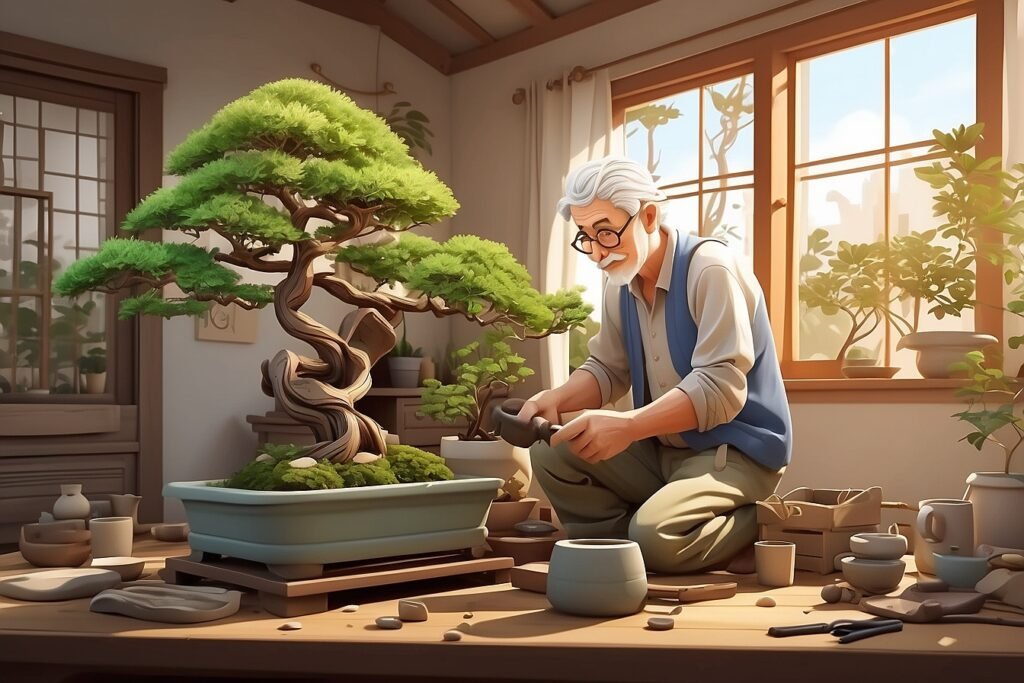Understanding Your Bonsai
Did you know about the Norfolk Island Pine Bonsai? It’s a cool conifer tree that’s native to Norfolk Island. People also love calling it the Christmas pine or star tree because of its unique needle forms and branch designs that give it a cheery appearance. This bonsai is part of the Araucariaceae family and is known for its proportional structure and wide-spaced branches, making it a great choice for indoor and outdoor spaces.

| Feature | Description |
|---|---|
| Native Origin | Norfolk Island |
| Family | Araucariaceae |
| Common Names | Christmas Pine, Star Tree |
| Branch Design | Unique needle forms and wide-spaced branches |
| Light Requirements | High light; can be kept outdoors in spring and summer |
| Temperature Tolerance | Bring indoors when temperatures drop below 45 degrees |
| Watering | Regular watering, do not let soil completely dry out |
| Humidity | Benefits from increased humidity, especially during cold months |
| Fertilizing | Necessary to maintain health and beauty |
| Training & Trimming | It is important for maintaining the miniature size |
| Repotting | Every 2-3 years for deciduous trees; every 4-5 years for evergreens |
| Insect & Disease Control | Use appropriate products to treat any issues |
Best Soil Mix for Optimal Growth
If you’re caring for a Norfolk Island Pine Bonsai, choosing the suitable soil for its growth and overall health is essential. To keep your bonsai happy, you’ll want to use a standard bonsai mix with pebbles on the bottom for drainage. This will ensure that the roots get enough air and don’t get waterlogged, which is essential because your plant won’t appreciate being in wet soil or root-bound.

The soil mix you choose should have the following characteristics:
- Well-Draining: Use pebbles at the base of the soil to improve drainage and prevent waterlogging, ensuring the soil can hold enough water to maintain moisture.
- Nutrient Rich: Choose a bonsai mix that contains organic compost for optimal nourishment and growth.
- pH Balanced: For optimal health of your Norfolk Island Pine Bonsais, ensure your soil mix has a slightly acidic to neutral pH.
Watering Wisdom: Detailed Advice on Watering Your Norfolk Island Pine Bonsai
If you have a Norfolk Island Pine bonsai, you’ll want to know how to handle it properly. The Christmas pine or star tree thrives in bright light and needs special watering techniques to stay healthy and gorgeous. Don’t worry; I can help you learn all about it!

- Frequency: Water your bonsai every two days during spring and summer and less frequently during autumn and winter. Avoid letting the soil become completely dry.
- Method: Water the entire root system by using a watering can with a fine nozzle. Water all around the base of the tree.
- Moisture Retention: Put your bonsai in a tray with water and gravel in winter to make it more humid and give it extra moisture.
- Overwatering: Don’t overwater your bonsai. This can cause root rot, which can be fatal. Watch for yellow or brown leaves and leaf fall as signs of overwatering.
- Underwatering: Avoid underwatering to prevent your bonsai from drying out and dying. If you notice curled leaves or arid soil, increase your watering.
Guide for Stress-Free Repotting of Your Norfolk Island Pine Bonsai.
Repotting your Norfolk Island Pine Bonsai can seem daunting, but with the right knowledge and tools, it can be a straightforward process. Here’s a step-by-step guide to help you:

- Choose the Right Time: Repot your bonsai in early spring before new growth appears to minimize stress on the Tree during its dormant period.
- Prepare Your Pot: The pot should have enough drainage holes to avoid waterlogging. Add a layer of pebbles at the bottom for extra drainage.
- Remove the Tree: Gently remove it from its pot, carefully not to disturb the root ball too much.
- Prune the Roots: Trick the roots to fit the new pot when repotting. But avoid pruning more than 30% of the root system to prevent stressing the Tree.
- Place the Tree in the New Pot: Place your bonsai and spread the roots.
- Add Soil: Add the bonsai mix to the pot, covering all the roots. Gently firm the soil to remove air pockets.
- Water Thoroughly: Water your bonsai thoroughly after repotting to settle the soil and aid the Tree’s recovery.
- Monitor Your Bonsai: After repotting, watch your bonsai for any signs of stress, such as wilting or leaf dropping. However, with proper care, it should recover.
Shaping and Pruning: Expert pruning tips
If you’re a proud Norfolk Island Pine bonsai owner, you must know how stunningly beautiful it is, right? But did you know that to keep it looking that way, you must take good care of it? It requires careful shaping and pruning to maintain symmetry and keep it miniature. Don’t worry; I’m here to help you with any questions or concerns about your little green friend.
To master the art of shaping your bonsai, follow these expert tips:

- Prune Regularly: Trim your bonsai regularly to maintain its miniature size. Prune each branch back to its farthest safe point, and avoid removing more than one-third of the foliage at once.
- Focus on Symmetry: Maintaining the balanced shape of the Norfolk Island Pine bonsai is crucial when pruning due to its natural symmetry.
- Use the Right Tools: Use sharp and clean pruning shears for clean cuts and to prevent disease spread.
- Best Time to Prune: Prune your bonsai during spring and summer when it’s growing.
Location and Sunlight
If you want to keep your Norfolk Island Pine bonsai happy and healthy, knowing the best spot to place it and what kind of sunlight it needs is essential. Don’t worry; I’ve got you covered. Here’s what you need to know:
- Indoor Placement: This bonsai needs high-light conditions indoors. It should be kept outside during spring and summer but moved indoors when night temperatures fall below 45 degrees.
- Outdoor Transition: Bring your indoor bonsai inside to protect it from the cold as the nightly lows approach 40 degrees.
- Window Selection: For the best indoor location, place your plants on a window sill that faces south, east, or west. If you only have northern exposure, use “grow lights” to supplement natural sunlight and provide sufficient light.
- Sunlight Duration: Bonsai needs 4-6 hours of sunlight daily for healthy growth and foliage.
Fertilizer Fundamentals:
If you’ve got a Norfolk Island Pine bonsai, did you also know it needs nourishment to blossom? Here’s what you need to know about fertilizing your bonsai so it can stay healthy and happy!
- Nutrient Needs: For your bonsai to grow and develop properly, it needs a combination of macronutrients (Nitrogen, phosphorus, Potassium) and micronutrients (Iron, Manganese, Zinc, etc.).
- Fertilizer Selection: Use a liquid fertilizer with an NPK ratio of 20-20-20 for balanced nutrient provision.
- Fertilizing Frequency: To keep your bonsai healthy, fertilize it once a week during spring and summer and once a month during autumn. Avoid fertilizing in winter.
- Application Method: Dilute fertilizer per package instructions and apply it to the soil, not foliage. Water the tree well before using it to avoid root burn.
- Signs of Nutrient Deficiency: If your bonsai shows yellowing leaves, stunted growth, and reduced vigor, it might lack certain nutrients. You can fix this by adjusting your fertilizing routine.
Propagation Techniques:
Norfolk Island Pine Bonsai (scientifically known as Araucaria heterophylla) is a fascinating species to add to your collection. This section will discuss how to propagate this species, but let’s explore some techniques that could effectively multiply it. Sound good?
- Seeds: Planting seeds in a growing medium under favorable conditions is the standard method for propagating several tree species, including the Norfolk Island Pine. It requires patience, as germination can take time.
- Cuttings: To propagate a plant, take a healthy stem or branch from the parent plant and plant it in soil or water. Ensure it has a suitable growing medium to develop roots.
Pest and Disease Prevention
Taking care of your Norfolk Island Pine bonsai can be a fun and fulfilling project, but it does require some love and attention. To keep your bonsai healthy and happy, I have some tips to share on preventing common pests and diseases.
- Regular Inspection: Check your bonsai regularly for pests or diseases by examining the foliage, stems, and soil. Detecting any issues early is crucial for successful treatment.
- Maintain Cleanliness: Clean your bonsai area by removing fallen leaves and debris promptly to prevent pests and fungi.
- Balanced Watering: Water your bonsai when the soil is not dry, but do not overwater, as it can cause root rot and fungal diseases.
- Proper Fertilization: Use a general-purpose liquid fertilizer at half strength to avoid over-fertilization, which can lead to salt build-up and root burn. This will help replenish the soil’s nutrients and keep your bonsai healthy and disease-free.
- Increase Humidity: To prevent spider mites during cold months, keep your bonsai in a shallow tray with gravel and water to increase humidity around the plant.
- Suitable Location: Place your bonsai in a spot that receives sufficient light and air circulation, whether inside or outside. Insufficient light can make your bonsai vulnerable to diseases and pests.
- Treat Promptly: Act quickly if you notice any signs of pests or diseases. Use the right products and always read and follow the instructions carefully.
Growth Patterns
Did you know that although it may look like a pine tree, it’s not a true pine? It belongs to the Araucariaceae family, which is a distinct lineage of trees. But don’t worry, I’m here to tell you everything you need to know about it!
- Balanced Shape: The Norfolk Island Pine has a triangular shape that resembles a Christmas tree, making it visually appealing.
- Upright Growth: The Norfolk Island Pine grows tall with widely spaced branches that reach out towards the light, forming a pyramid-like shape.
- Leaf Loss: It’s common for the lower leaves of a maturing tree to die off as it grows taller. This is a natural part of its growth pattern and doesn’t indicate any illness or improper care.
- Long Lifespan: A Norfolk Island Pine bonsai can live indoors for over 150 years with proper care, which includes correct watering, humidity levels, and fertilization.
- Cold Sensitivity: The Norfolk Island Pine should be kept indoors during winter in most climates as it cannot tolerate cold temperatures or frost.
- Training and Trimming: The bonsai tree can be trained in various styles but avoid heavy pruning. Gentle training and trimming will help maintain its miniature size.
Special Considerations:
- Humidity Levels: To maintain a humid environment for your bonsai, place it in a shallow tray filled with water and gravel. The water will evaporate and create a humid microclimate around the tree.
- Insect Inspection: Inspect your bonsai repeatedly for insects and mold. Detecting issues early is crucial in preventing infestations. If you spot any pests or diseases, use the right products to treat them promptly.
- Child and Pet Safety: To ensure the safety and well-being of your bonsai, keep it away from children and pets. Rough handling can cause damage to this delicate tree.
- Plant Companions: Adding other plants and bonsais to your Norfolk Island Pine bonsai helps maintain humidity levels and enhances the aesthetic appeal of the environment.
- Location:
- Move your bonsai indoors when night temperatures dip below 45 degrees.
- Keep it near a south-facing window sill or an east or west exposure.
- During warmer months, keep it outside for more sunlight.
- Watering: Water your plant until it drains out of the pot; ensure the soil is completely dry.
- Fertilizing: Feed your bonsai monthly with a general-purpose liquid fertilizer at half the recommended strength, except during winter.
- Training and Trimming: Train and trim your bonsai gently to maintain its miniature size. Avoid heavy pruning as it is not suitable for this particular species.
- Repotting: For deciduous bonsai trees, repot every two to three years. For evergreen trees, repot every four to five years. Do it in mid-summer by removing the outer and bottom fourth of the roots and putting them back in the pot with fresh soil.
Conclusion
If you’re a bonsai enthusiast, you’ll want to add the Norfolk Island Pine bonsai to your collection. It’s a unique and exotic specimen from the Araucariaceae family that will captivate you with its distinctive triangular outline, light-green foliage, and tall stature.
To keep your bonsai happy and healthy, ensure it gets plenty of light, regular watering, and increased humidity during colder months. You won’t need to prune too much, but keep an eye on it and trim it to maintain its miniature size.
It’s also important to feed your bonsai with a balanced liquid fertilizer during the spring and summer months and report it every two to four years for optimal growth. Though it’s generally resistant to pests and diseases, keep an eye out for scales – the most common issue for this species.
Your Norfolk Island Pine bonsai can live for over 150 years with love and attention! It’s not just a tree – it’s a living piece of art that will evolve, reflecting the beauty of nature in miniature form. Enjoy your journey with this beautiful bonsai!
FAQs: Norfolk Island Pine Bonsai Care
Where is the Norfolk Island Pine Bonsai native to?
The Norfolk Island Pine Bonsai is native to Norfolk Island, a small island in the Pacific Ocean.
Is the Norfolk Island Pine Bonsai a true pine?
No, it is not a true pine. It belongs to the Araucariaceae family.
What kind of light does the Norfolk Island Pine Bonsai prefer?
This bonsai prefers high light and can be kept outdoors during spring and summer. During winter, it should be brought indoors and placed on a south-facing window sill, or an east or west exposure.
How often should I water my Norfolk Island Pine Bonsai?
Watering should be done before the soil appears dry. The soil should not be allowed to become completely dry.
How can I increase humidity for my Norfolk Island Pine Bonsai?
Humidity can be increased by placing the bonsai in a shallow tray filled with gravel and water.
What type of fertilizer should I use for my Norfolk Island Pine Bonsai?
A general-purpose liquid fertilizer can be used to replenish the soil’s supply of nutrients.
Should I trim or prune my Norfolk Island Pine Bonsai?
Training and trimming should be done to keep the tree miniature. However, pruning should be done with caution as the tree may not tolerate heavy pruning.
How often should I repot my Norfolk Island Pine Bonsai?
Repotting should be done every two to three years for deciduous trees and every four to five years for evergreens.
What should I do if my Norfolk Island Pine Bonsai has insects or diseases?
Insects and diseases can be treated with appropriate products. Regular inspections are key to preventing infestations.
Further Reading And Resources
- Mastering the Art of Growing Birch Bonsai (Betula): A Comprehensive Guide
- Alberta Spruce Bonsai: A Detailed Guide to Pruning, Growth, and Maintenance
- The Comprehensive Guide to Caring for Your Mugo Pine Bonsai
- Mastering the Art of Growing Bonsai Banana Trees: A Comprehensive Guide
- The Ultimate Guide to Nurturing Norway Spruce Bonsai
- The Quaking Aspen Bonsai: A Unique Artistry in Miniature Forestry





